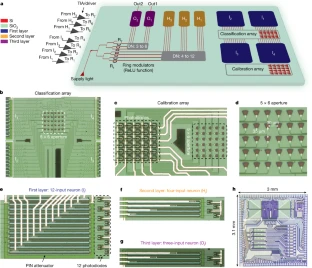Nanowerk June 4, 2022
In the optical domain, despite advances in photonic computation, the lack of scalable on-chip optical non-linearity and the loss of photonic devices limit the scalability of optical deep networks. Researchers at the University of Pennsylvania created an integrated end-to-end photonic deep neural network (PDNN) that performs sub-nanosecond image classification through direct processing of the optical waves impinging on the on-chip pixel array as they propagate through layers of neurons. In each neuron, linear computation was performed optically, and the non-linear activation function was realized opto-electronically, allowing a classification time of under 570 ps, which is comparable with a single clock cycle of state-of-the-art digital platforms. A uniformly distributed supply of light provided the same per-neuron optical output range, allowing scalability to large-scale PDNNs. They demonstrated two-class and four-class classification of handwritten letters with accuracies higher than 93.8% and 89.8%. Direct, clock-less processing of optical data eliminates analogue-to-digital conversion and allows faster and more energy efficient neural networks for the next generations of deep learning systems…read more. Open Access TECHNICAL ARTICLE

The implemented photonic classifier chip. Credit: Nature (2022)